In any apartment or private house, blockages occur over time. They come in different types and degrees of difficulty. In the article, we will consider how to deal with blockages of sewer and water pipes, and also talk about how to clean heating systems and stove chimneys.
Do-it-yourself sewer pipe cleaning
Depending on the degree of pollution, they are used different ways... If the blockage occurs for the first time, then it is likely that one of the following will help to cope with it. folk remedies... But when the pipes are old, due to the dirt deposited in them, blockages occur regularly, a stronger chemical will be required. In the case when it did not help either, you have to resort to the help of specialists, who have at their disposal a special cable for cleaning the pipes. You can buy it at a plumbing store and do the work yourself. Next, we will consider all three methods in detail.
Sewerage cleaning by folk methods
Method one
Permitted for use only on metal pipesah, since it is not recommended to pour boiling water into plastic pipes.
- First, they scoop out the water and free the drain as much as possible from debris.
- Pour about 1-1.5 boiling water into the drain hole and leave it for 15-20 minutes.
- Try to clear the blockage with a plunger. It should fit snugly against the surface. Repeat the procedure until you can clean the drain well.

- Then add a glass of baking soda and immediately pour 3 cups of boiling water over it.
- Due to the creation of an alkaline environment when using soda, fat and dirt blockages in the pipe are cleared.
Method two
- If it was possible to partially remove the blockage and the water began to leave, but slowly, then you can use this method.
- To do this, half a glass of dry baking soda is poured into the drain freed from water and debris and immediately poured with table vinegar.
- As you know, a reaction is formed with the release of a large amount of foam. So that it does not come out all out, for the duration of the action of these substances (3 hours), you must try to plug the drain hole.
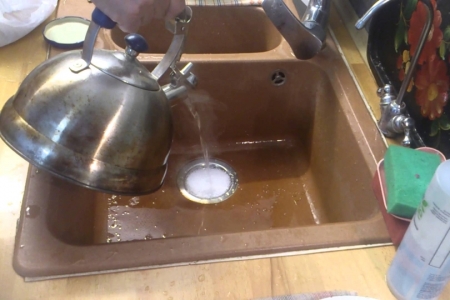
- After removing the plug, the drain is washed with a small amount of boiling water.
Method three
- Pour baking soda and salt into a glass, mix. Then it is poured into the hole where the blockage occurred.
- Pour boiling water over them and leave for the whole day. With some frequency, you can add boiling water, but nothing else should get there during this period of time.
Tip: to prevent blockages, and not just deal with their consequences, it is recommended to prepare a special mixture :
- Mix soda and salt in equal proportions, adding to them a quarter of the resulting volume of tartar. The resulting mixture must be very carefully moved and tightly closed in a jar.
- For prevention, this composition is poured into the drain hole and spilled with boiling water. And almost immediately rinsed with cold water.
DIY sewer pipe cleaning tools
There are special firms specializing in cleaning sewer pipes... In addition, you can call the plumber from the home management company. But all this is troublesome and takes a lot of time. Therefore, most apartment and house owners prefer to deal with blockages on their own. Today the market is replete with a selection of different strong chemical solutions that help to cope with this task. Let's consider their classification to make right choice at the time of buying.
Classification of means for cleaning the sewage system by release form:
- dry (loose). Most often sold as a foil bag for one use. Produced in powder or granule form;
- liquid (gel-like). They have a more gentle effect on pipes, do not damage them and are easily washed off. For home use, such preparations are more acceptable, since they are safer than dry powders.
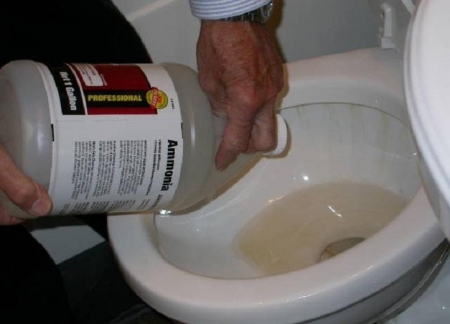
Depending on the active ingredient blockage cleaners are divided into:
- acidic. Recommended for use in bathrooms, as they do an excellent job of dissolving hair and soap deposits;
- alkaline. They are aimed at dissolving fatty blockages, and therefore are recommended for use in the kitchen.
Popular blockage cleaners
- Mister Muscle... This brand produces a wide range of household chemicals. The most powerful preparation for cleaning sewer pipes is called "anti-clogging". It is able to dissolve even a dense plug of deposits. There are also a number of drugs on the market for preventive treatments.
- Tyreth... This DIY pipe cleaning solution is widely advertised. It is of three types: formulations with a small amount of an active component for prevention, for small blockages in which water leaves slowly and for serious traffic jams that prevent water from leaving.
- Pothan... This is a highly concentrated solution for cleaning sewer pipes in an apartment with your own hands. The tool is universal and can be used to remove fatty or lime blockages. It is necessary to work with him with extreme caution, using personal protective equipment.
- Mole... For half a century, this tool has been successfully coping with household sewage blockages. But solutions with this name are produced by several manufacturers at once. Therefore, they often differ slightly in composition. Before using it, it is recommended to read the instructions on the packaging.
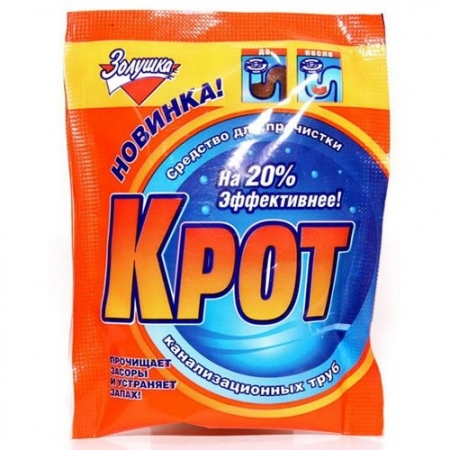
- Flop. It is a granular powder. For metal pipes, the manufacturer produces a product that needs to be poured with boiling water, and for plastic pipes - with cold water. Therefore, before buying, you need to read the powder annotation.
DIY pipe cleaning cable
There are several types of pipe cleaning ropes on the market. They can be either manual or electric. In addition, they differ in diameter:
- for pipes whose diameter is less than or equal to 50 mm, a 100 mm cable is used;
- with a pipe diameter of 50 to 100 mm, a cable from 10 to 16 mm is required;
- for thick pipes, the maximum diameter of the plumbing cable is selected, which should exceed 16 mm.
In appearance, they are divided into:
- wire rope is the most common type made from steel. It looks like a rope with flat ends. It is flexible and elastic at the same time, which allows you to easily go through all the turns of the sewer pipes, but at the same time push the blockage;
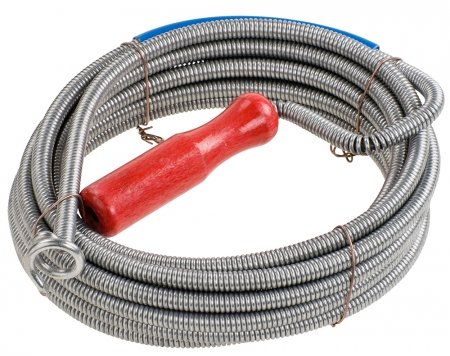
- flexible shaft - has a steel core around which a flexible metal cable is wound in a spiral. For the convenience of work, it has a handle. Suitable even for difficult blockages, as it is produced with a diameter of up to 28 mm and a length of up to 50 m;
- metal tape. At one end it has a tip in the form of a quadrangular peak, and at the other a handle. Such a cable, as a rule, does not exceed a length of 30 m;
- spring cable - simple construction, consisting of a handle and an elastic steel spring attached to it.
This is the main classification of cables suitable for clearing blockages with your own hands. There are even more complex models, but due to their high price, only professionals use them.
To increase the efficiency of cleaning sewer pipes with your own hands, different nozzles are sold for cables:
- "Ruff" - from layers on the pipe walls;
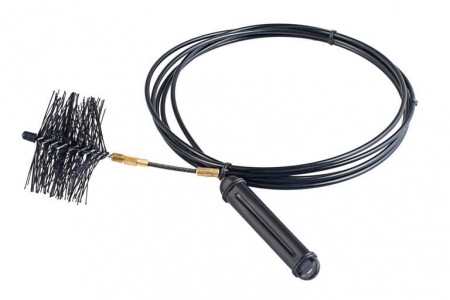
- punching - for removing old or difficult blockages;
- bottom - cope with construction waste;
- hook - for removing foreign objects.
Cleaning sewer pipes with a cable
- Having lowered the end of the cable into the toilet bowl drain, they begin to push it, making rotational rotations by the handle.
- As soon as the cable runs into a blockage, it becomes difficult to rotate it. Therefore, you need to start moving it up and down alternately until there is a passage for the unhindered movement of the cable.
- Having taken out the cable, you can pour boiling water into the drain hole or use one of the folk methods described at the beginning of the article.
Do-it-yourself water pipe cleaning
First of all, it is necessary to consider how expedient the cleaning of the water pipes is. Often in old houses they have such strong deposits that it will be much easier and more effective to replace them with new plastic pipes than trying to clean them. In the event that the blockage is localized in a limited section of the pipe, it makes sense to clean it. There are several ways how to clean water pipes with your own hands.

- Cleaning with hammering... This method, available to all, is not always effective. First, the strainer (if any) is removed from the tap so that it does not interfere with the exit of debris. Then they turn on cold water to the maximum and begin to gently tap with a hammer along the entire available length of the pipe. In this case, the internal plaque moves away from the walls and is pushed outward by the flow of water.
- Cleaning with a cable... For pipes, you need to take the thinnest cable. First of all, you need to shut off the water in the pipes, then remove the mixer and siphon. A cable is inserted into the pipe and deeper with rotational movements until it rests and clears the blockage. Then a siphon with a mixer is installed and cold water is turned on so that it flushes the pipe from small particles of debris.
- Using chemicals... A large number of products are sold for blockages in water pipes. If they have not coped, you can use the "mole", but we must remember that it is much more toxic and is intended for sewer blockages. First, shut off the water, remove the mixer and siphon. Gloves and preferably goggles should be worn. Since when interacting with rust, most of the chemical reaction takes place with a large release of caustic foam. Having poured the agent into the pipe, it is left for a while. Then the mixer is mounted back and the water is turned on. Flushing should take at least 15 minutes. The product is poisonous, so it is better to rinse it several times.
Do-it-yourself heating pipe cleaning
- If the battery does not heat partially, it means that it needs cleaning. If there is no experience, then it is better to call a plumber, but if you are confident in your abilities, you can carry out the work yourself.
- The first step is to drain the water from the heating system. It is not difficult to do this in a private house, but in apartment building you need to go down to the basement. Therefore, it is necessary to take the keys to it in advance from the senior at the entrance or from the service organization. Also notify the residents of the riser in advance about the work being done.
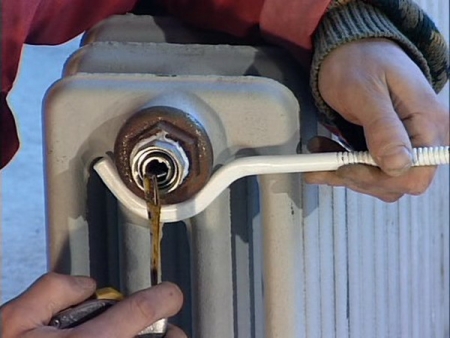
- The pipes are unscrewed from the battery and it is dismantled. If the batteries are old, then the couplings are difficult to unscrew, and sometimes they have to be cut. In addition, cast iron radiators, which are installed in all Khrushchev buildings, are very heavy. It is very difficult to lift them alone.
- After removing the battery, they will inspect it. If sludge or rust deposits are visible in the holes where the pipes were attached, they are cleaned by hand.
- Further work should be done in the bathroom or outside. Having turned the radiator vertically, the lower hole is tightly plugged, and water is poured through the upper one. Then the water is released, the flow must be strong enough to wash out all the dirt. This physically demanding work is repeated until clear water flows out.
Tip: You can make your work easier and use a high-pressure car wash.
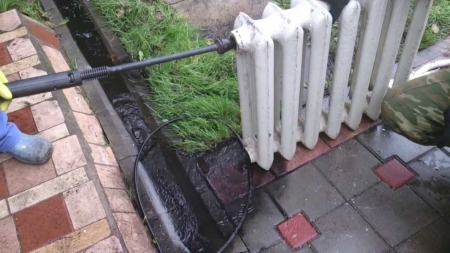
- If the contamination is so strong that flushing does not help, then acid-based chemical cleaning solutions are poured instead of water.
Important! Do not use such products for aluminum batteries.
- In addition to silting up the radiator, most of the deposits accumulate in the pipes themselves. In city apartments, most of the pipes are located vertically, so it is quite possible to clean them. It is much more difficult to do this in a private house, where the wiring runs throughout the floor.
Cleaning heating pipes without dismantling the battery:
- chemical cleaning... Depending on the possible contamination, acidic or alkaline solutions are used. This method is available and cheap, but it is allowed to be used only for pipes and batteries made of ferrous metals;
- hydrodynamic cleaning available only when contacting specialists. They clean the heating system with high pressure water supplied through special equipment.
Do-it-yourself chimney cleaning
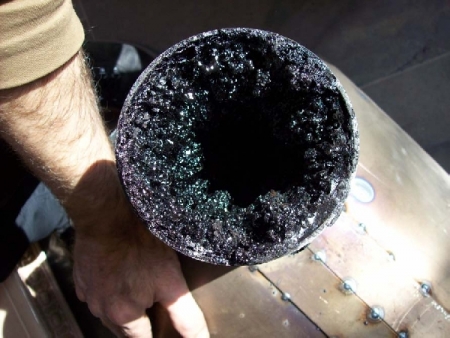
When wood is burned in a stove or fireplace, not only smoke is released, but also soot that settles in the chimneys. In addition to soot, essential oils and resins also settle on the walls, and if the stoves are used improperly, these contaminants clog the chimney even faster. This may be due to the following factors:
- the type of wood from which the firewood is made... It is difficult for an inexperienced person to determine the type of firewood in appearance, while their quality greatly depends on this. It is unacceptable to use for the firebox coniferous wood. It has a low heat transfer, and when it burns, it emits a huge amount of resins that settle in a sticky layer on the chimney and attract soot;
- quality of firewood... Even birch firewood is allowed to be used after drying. Putting freshly cut or raw logs into the firebox is not recommended. This is due to the fact that during combustion a lot of moisture will be released, which, settling on the walls of the chimney, will attract soot. This will lead to very fast clogging;
- incineration of household waste... Often, the owners of houses where there is stove heating, throw into the firebox not only firewood, but also a variety of waste: pieces of paper, various wrappers or food leftovers. Such disposal causes the release of various fats, toxic fumes and resins. This is what leads to the need for frequent cleaning of the chimney with your own hands.
At the slightest sign of blockage, you must immediately begin to clean it. Otherwise, it can lead to a decrease in traction. This threatens that the smoke will go through the firebox to the outside, filling the room with carbon monoxide, which is deadly. In addition, a soot blockage is highly flammable, and accidental sparks can cause a fire.
Methods for cleaning chimneys
Mechanical method
- Most often, a chimney sweep is called for this, but if there are no such professionals, you will have to do the work yourself. In specialized stores, you need to purchase an oven ruff. It is a long cord, equipped with a handle at one end, and a weight for weight and a metal brush at the other. If the pipe is metal, then only a plastic pipe can be used.
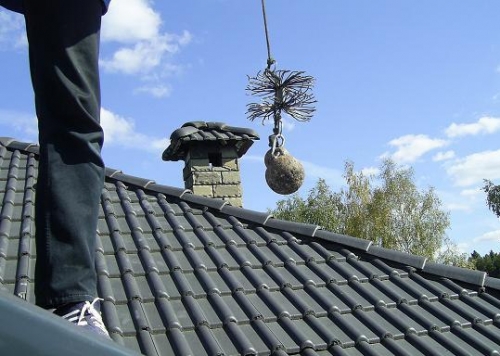
- When cleaning the pipe from soot from the roof, it is important to observe safety precautions, using a special safety rope with reliable carabiners.
- A protection or deflector is removed from the top of the pipe. First, with the help of a broom, all the available debris is removed from the upper part. For initial cleaning, remove the ruff from the cable, leaving only the weight. It is lowered into the chimney and begins to tap on the walls to remove the top layer of soot.
- When the main part of the blockage is removed, a brush is put on the cable and a thorough cleaning begins. To do this, it is lowered to the desired depth and pulled upward, at this time it cleans the layers. The procedure must be carried out until complete cleaning. This is a monotonous and difficult job. It will take a lot of time and effort.
Tip: During cleaning, soot will fly out of all open areas. Therefore, before work, it is necessary to tightly close all the dampers and the firebox. In addition, it is better to additionally hang a damp cloth on all exits to protect the room from ash.
Chemical method
- It is recommended to use a chemical method as a preventive measure. It will eliminate the need for time-consuming mechanical chimney cleaning.
- Special logs are sold, which include special chemical additives, which, during the combustion of the briquette, are released and react with the resins on the pipe walls. From this they become fragile and easily move away.

- It is recommended to repeat the procedure every 2 months (with intensive use of the oven) or immediately before mechanical cleaning.
Tip: in order not to buy expensive chemical logs, you can use proven folk methods:
- when kindling the stove, ordinary edible salt is poured onto the firewood, it is able to soften the deposits of soot and even tar;
- strong influx of soot can be quickly removed if 2 naphthalene tablets are thrown on them while burning firewood;
- periodic heating of a fireplace or stove with alder wood will protect the chimney from dirt settling. But they cannot warm up the house.
A blockage in the sewer is one of the most unpleasant moments that any city dweller can face. Especially if he lives in an apartment building. It will be very difficult to achieve a positive result on your own. Therefore, if necessary urgent elimination of sewage blockages, you will have to call experienced specialists. They have all the necessary equipment for this. And first of all, you need to make a call if it turns out that the blockage has occurred in the riser of the sewer system.
If you do not do preventive cleaning of the sewer at least twice a year, the case may end in a blockage. And this is already bad, especially when it happens in a riser, and not in a siphon under a plumbing fixture.
To date, the elimination of blockages in Moscow is carried out in several ways:
- mechanical
- chemical
- thermal
- hydrodynamic
In some cases, you can do everything yourself. But if the blockage is serious, you will need the help of specialists.
The price for thermal elimination of blockages in the sewage system is the most acceptable. After all, you have to pay only for the use of gas or electricity to boil the water. Boiling water must be poured into a plumbing fixture. But he doesn't always help. Therefore, you can try a plunger or plumbing cable if you have one in your closet. If not, chemicals can be used. But the cost of the hydrodynamic elimination of blockages is the highest. A special hydrodynamic unit is needed here. You can rent it or call a specialist to remove the blockage with a high pressure water jet.
Almost every person, deciding to repair or build a house, is very attentive to the little things and nuances. The further comfortable environment in the room will depend on how the sewage system is laid.
The main reasons for the formation of blockages in the sewer
Deformation of pipes, poor-quality material, non-observance of operating rules - all this leads to sewage blockages and the need to call a master. Of course, initially the problem can be solved independently (with the help of aggressive chemicals). But if the cause of the blockage is not identified, after a short time the problem may return again.
A more logical solution is to timely call a service that specializes in solving these problems. Sewer blockages should be cleared by competent, professional and experienced workers.
Cost and terms of eliminating sewage blockages in Moscow and Moscow region
Naturally, the cost of eliminating sewer blockages depends on which method is used for this. It is also important what kind of blockage happened. But for the owner of an apartment, restaurant or other institution, this is already a secondary issue, because it is more important to solve this problem as soon as possible. One of the demanded, proven and reliable companies that produces diagnostics and solves all problems with sewage is "Hydro Chist". Inexpensive prices, prompt deadlines for the completion of work, effective methods - elimination of blockages, special equipment and the availability of skills - all these are integral parts of the company's work. Therefore, in our company you can call a service that will bring the sewage system into working condition with high quality and inexpensive!
The situation is familiar: at the most inopportune moment, instead of running down the drain, water tends to pour out of the sink onto the floor? Unfortunately, the use of smooth plastic pipes and expensive siphons does not guarantee that a blockage does not form in the sewer. What to do if the sewer is clogged - how to clean the pipe and get rid of the plug without shutting off the water for the whole day before the plumber arrives? It is unlikely that you will be able to cope with complex blockages on your own, but solving the problem with a clogged drain in the kitchen or bathroom is real.
First of all, you should identify the cause of the obstructed outflow of water, especially if this problem occurs constantly. Among the most common reasons for the systematic appearance of blockages:
- Use on the branches from the siphon of corrugated hoses. The surface of a thin hose for greater strength and flexibility is made in the form of an accordion - plaque accumulates in the folds of the corrugation, which eventually blocks the inner lumen.
- Kinks of flexible corrugated pipes. Fixing the problem is simple: just remove and reinstall the hose so that there are no sharp bends. Often the cause of kinking is too long a hose.

Kinked corrugated hose - guaranteed blockage
- Cast iron pipes. Old sewer lines will clog up regularly, no matter how often the owners perform preventive cleaning. The reason is in the deposits inside the pipe. Cast iron is susceptible to corrosion, plates of rusty metal, breaking off from the walls, form blockages, and threads, wool and hair that fall into the pipe cling to the damaged walls. There is only one way out - replacing the outdated system.
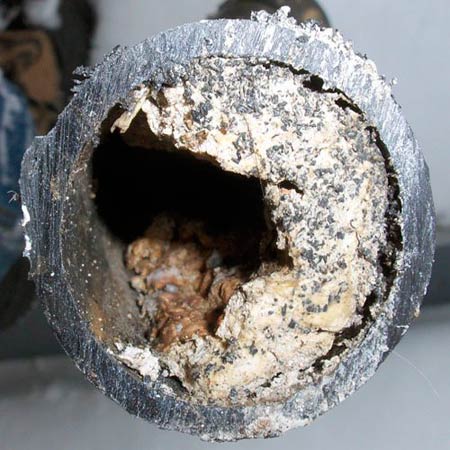
Cast iron pipes after several years of operation
- The most commonplace reason is the irregular shape of the drain grates and the absence of grease traps. The question is especially relevant for kitchen sinks. Food residues get into the drain - after accumulation in the siphon, dense lumps collect in the pipe, forming fatty solid plugs. The correct shape of the lattice is a flat blind plate with frequent narrow longitudinal holes.
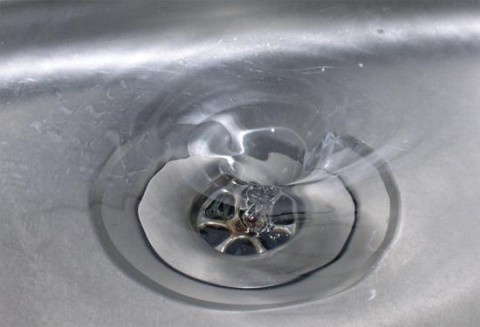
This grille should be replaced
- Ignoring the basic rules of operation. Apartment owners forget that the domestic sewage system is designed exclusively for the discharge of liquid soluble waste. Paper, rubbish, wet wipes are just a few of the items that can cause complex blockages.
Having found one or more of the listed reasons in the apartment, try to resolve the issue radically: replace the old clogged pipes, install grates with grease traps - you will not have to call the masters to clear the sewer blockages for several decades.

Types of blockages and typical places of their formation
In any home sewage system, no matter what pipes and plumbing are installed, there are 3 areas where blockages most often occur:
- Siphon and adjacent branch.
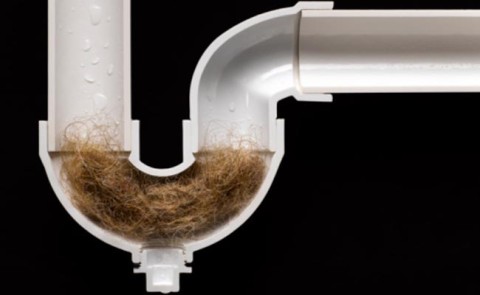
- A branch of the branch located one meter from the siphon.
- The entry point of the local sewer pipe into the common house riser.
You can find a place where the inner lumen is blocked on your own. If 1 section is clogged, then there is a delay in draining only at one point - in the sink, bathtub, or toilet bowl. To check how far from the drain grate the plug is, simply turn on the tap. If the water starts to rise and does not drain at all, the siphon is clogged.
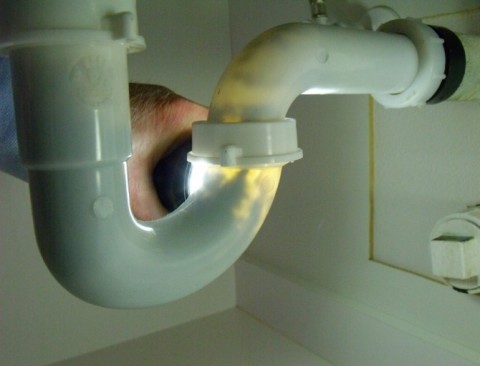
You can check the condition of the plastic siphon with an ordinary flashlight
If at first the water passes freely, and after a while the overflow from the drain grate begins, it means that the blockage is located at a distance from the siphon, in the area between the water intake point (sink, bathroom) and the entrance to the common outlet pipe. When the riser is clogged at the junction of the general and apartment system, problems arise with all the plumbing at the same time: the drain is difficult at all points.

Accumulation of scale and organic debris inside the pipe
To decide how to clean the sewer yourself, in addition to finding the place of blockage, it is necessary to determine the type of pollution. All blockages in the sewer system are conventionally divided into 3 groups.
Operational blockages
Grease gets into the sink with water, especially in the kitchen. Hot vegetable oil, the fat is drained into a siphon. On contact with cool water, the oil becomes thick and sticky. The crust adhering to the walls collects on its surface all particles that enter the drain: food debris, small pieces of kitchen sponges, fibers. So, within a few months, a strong plug is formed, narrowing the pipe lumen.
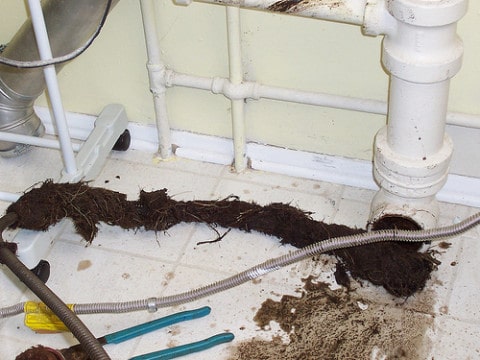
Difficult operational blockage: sewers have never been cleaned
Mechanical plugs
Overlap the inner lumen of the sewer pipe all insoluble objects and materials that enter the drain. Most often, foreign objects fall into the toilet: rolls toilet paper, rags, personal hygiene products. Wet wipes can create an impenetrable blockage in a matter of hours, especially in cast iron pipesoh. The fabric from which the napkins are made has a fibrous surface that clings to the inner walls of the pipe.
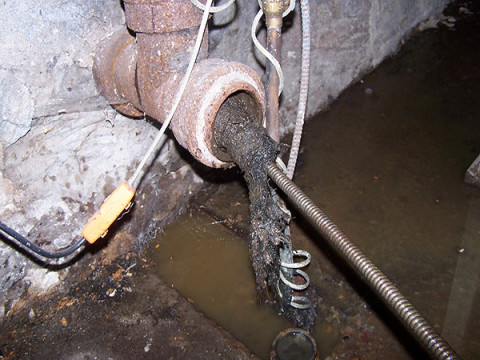
Complete lumen overlap: mechanical blockage
Technical blockages
Defects in the construction of the sewage system in the apartment are the cause of regular blockages. If the diameter of the pipe is incorrectly selected, the slope is incorrectly set, there are sharp turns of the pipeline at a large angle that are not equipped with corner joints, then the system will have to be reinstalled.
After determining the point where the sewer is clogged, and the type of pollution, a pipe cleaning method is chosen that will help to cope with the blockage.
Sewerage cleaning by folk methods and chemical means
Among the ways to eliminate sewer blockages that you can apply yourself without calling the plumber:
- Folk recipes using tools that are always at hand in the kitchen.
- Special household chemicals.
- Simple mechanical pipe cleaning methods: plunger and cable.
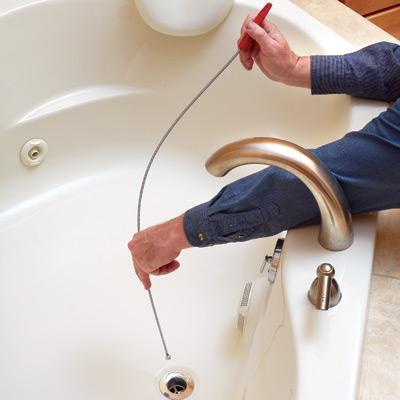
Before you start cleaning the drain in your apartment, be sure to find a pair of household rubber gloves - the stronger the better. Ordinary medical will not work, thin latex may not withstand if it comes into contact with acid or alkali.
How to deal with simple contamination with ordinary boiling water
The first assistant in the fight against fatty blockages is boiling water. Boil about 2 L of water. Pour boiling water into the sink drain. Proceed carefully, pour boiling water slowly, in a thin stream. Use a thick hold to avoid scalding your hand with the hot steam.
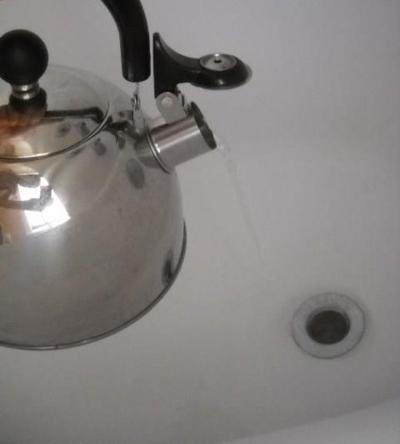
Just pour boiling water over the drain.
Leave the boiling water in the drain for 20 to 30 minutes. Hot water will melt the top layers of the fat crust, thus providing access to the center of the blockage. Boil another portion of water after half an hour.
Pour a pack of table salt into the drain hole, after 5 minutes pour boiling water on top. Use ordinary rock salt, refined fine "Extra" will not work. Large crystals of salt corrode the mass of the blockage, and boiling water poured on top will dissolve the remaining fat.
Salt is the easiest way to unclog kitchen drains. If the pipe does not clear after refilling the water, try using baking soda.
How to use baking soda correctly
To clean the sewer, ordinary baking soda is used - as an ambulance for simple blockages in the siphon and adjacent pipes. Baking soda can be used alone or in combination with other products that are always in the house - with vinegar, dishwashing liquid, citric acid and tartar.
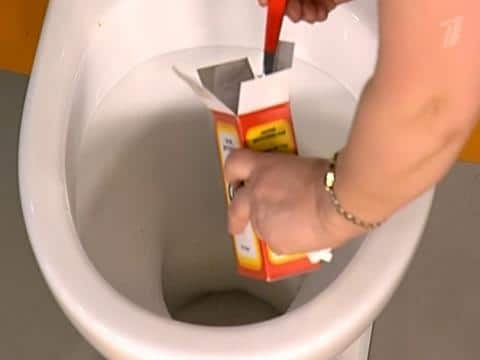
You can pour soda directly into the drain
Simple recipe: pour a whole bag of baking soda into the drain hole and pour a little boiling water over it. You can leave the mixture in the siphon for a long time - the soda will not damage the pipe walls. After a few hours, the cleaned pipe must be rinsed with copious amounts of water.
To cope with more complex blockages, cleaning the sewer with soda and vinegar helps. The substances are not mixed before filling. First, about 200 g of soda is poured into the drain, the same amount of vinegar is poured on top. The reaction that starts in the pipe may be too intense and foam will come out of the drain hole. In this case, you can plug the drain with a plug. The time during which the solution takes effect is from several minutes to 1 hour. It doesn't make sense to wait any longer. Better to repeat the procedure.

Soda with vinegar in a 1: 1 ratio
Instead of table vinegar, use concentrated vinegar, a strong solution citric acid or tartar. The proportion of the acid solution to the amount of soda should be 1: 1. As a fat solvent, especially when cleaning in the kitchen, dishwashing liquid is added to the mixture: soda will corrode organic matter, and the agent will dissolve the fat accumulated on the walls. Before using soda solutions, the clogging plug is treated with boiling water to soften.
Heavy artillery: caustic soda
If it was not possible to clean the sewer system with ordinary soda with table vinegar, there is a more aggressive remedy - caustic soda. It is worth using caustic soda with caution and only in emergency cases when there are no special cleaning agents in the house.
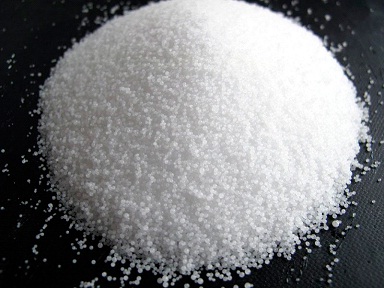
Caustic is produced in 2 types: in the form of granules and gel. Using the product at home is dangerous. A lot of heat is generated during the reaction. The pipe into which caustic soda is poured to clean the sewage system can heat up to 60 - 65 o. Therefore, a substance for PVC pipes is used with extreme caution - the walls can be deformed under the influence of excessive temperature.
Also, you cannot use caustic if the sink or bathtub is covered with enamel. The baking soda will eat away at the coating in a few hours. When working with the substance, be sure to protect exposed skin, face and eyes. Special tall vinyl gloves and plastic goggles are required. A corrosive product can cause burns and irritation of the skin.
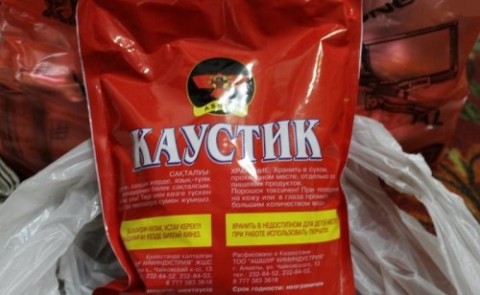
Before pouring into the sewer, the dry substance must be diluted with water in the proportion: 1 part of soda to 2 parts of water. Stir the solution in a sturdy, thick-walled plastic container. After dissolution, the liquid is poured into the drain hole.
To eliminate local blockages in siphons, it is enough to pour a few tablespoons of caustic into the drain and add 250 ml of boiling water on top.
The solution can be left in the pipes for a maximum of 1.5 - 2 hours. After this time has elapsed, the system must be flushed well, leaving the tap open for 5 - 10 minutes. The remains of soda, flowing through the pipes, will clean the inner walls of organic deposits.
Alkaline and acidic household products
How to clean the sewerage system in a private house using store products? First of all, choose the right composition. The main active ingredients that are part of all industrial formulations without exception:
- Alkali.
- Acids.
As auxiliary cleaning agents, manufacturers add surfactants to the composition, which disinfect the pipe from the inside and dissolve the fat.
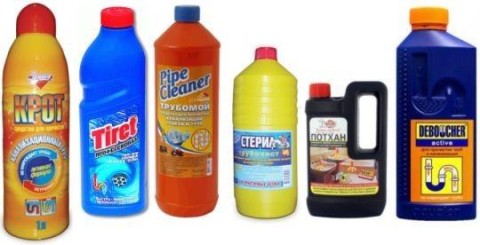
Chemistry for removing blockages in the sewer
The form of release of household chemicals is diverse: gels, powder, granules. The most convenient are portioned bags with granules and liquid, which is poured directly into the pipe. The mechanism of action and method of application directly depend on the active substance. Therefore, it is necessary to use the funds strictly following the instructions.
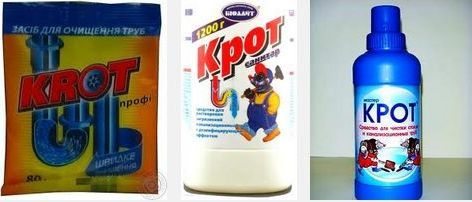
Portion bags and liquid
Alkaline compounds are ideal for dealing with sewer blockages in kitchens. The lye dissolves the fat within a few minutes. Granular formulations are poured dry into the drain. Pour in water in the amount specified in the instructions. Some products are poured with cold water.
Acidic formulations are more aggressive. Acid copes with solid deposits inside pipes, with residues of detergents, organic dirt. Therefore, acid-based products are recommended for cleaning pipes in bathrooms. Use acid with caution on enamelled surfaces. It is necessary to ensure that acid does not come into contact with the chrome-plated or nickel-plated taps: the agent can leave stains on the surface.
Mechanical elimination of deep blockages
Improvised means (soda, vinegar) and chemical compositions it is advisable to use when at home you need to clean the sewer in areas near the drain holes. Chemical action is not enough to remove deep blockages. You will have to use a plunger or a cable with a tip.
How to use a plunger correctly
The easiest and fastest mechanical way to remove blockages is to flush the siphon. An unpleasant smell from the sink indicates that the hole in the siphon is clogged. To remove dirt, simply unscrew the siphon, clean out the lumps of dirt and thoroughly wash the pipes with dish soap.

Remove and rinse: a quick way to clean the siphon
The plunger is a standard device used when cleaning pipes if the blockage is below the siphon. You can use the plunger both independently and after pouring a cleaning compound into the pipe.
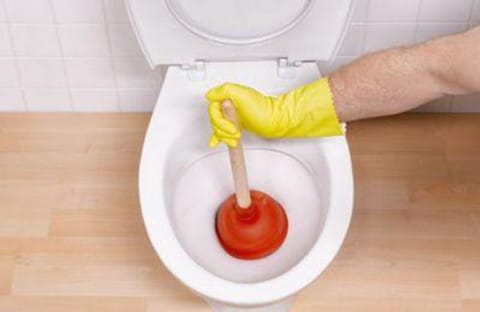
Toilet plunger with large diameter bowl
When working with a plunger, observe simple rules:
- The bowl should fit snugly and tightly to the sink around the drain. To improve suction, the rim of the bowl can be lubricated with silicone.
- Fill your sink with water. The water layer should overlap the wider part of the bowl by 1 cm.
- Move the handle quickly and forcefully. Usually 3 - 4 water hammer is done with a minimum interval.
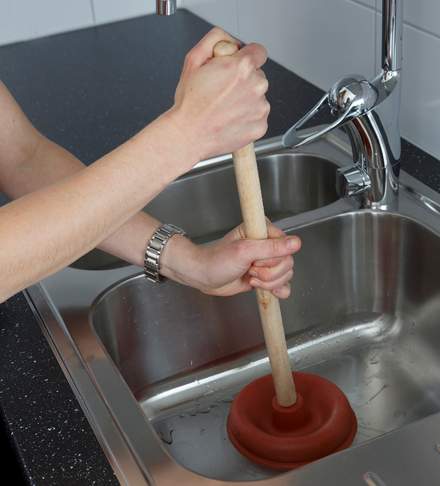
When cleaning a double sink, close the drain hole of the second sink
- Overflow holes in sinks and bathtubs located above the drain point must be sealed so that the impact force does not diminish.
Improved models have come to replace simple plungers with a handle - pneumatic devices with a handle, a valve and a convenient narrow rubber gasket at the bottom. The narrow nozzle fits easily through the drain - a blockage can be removed in the depth of the pipe.
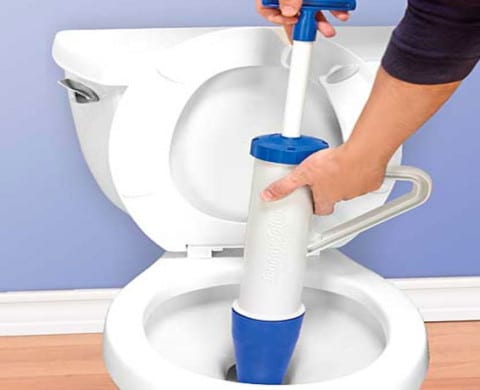
Pneumatic valve plunger
It is easier to use a pneumatic plunger. Install the device so that the center of the tip coincides with the center of the drain hole. Extend the valve handle and push it back sharply. The force that must be applied is minimal, and the force of the water hammer is several times greater than when using a mechanical device.
Some craftsmen improve the standard plunger on their own. Use an old back-blow vacuum cleaner to create pressure. A bowl from the old plunger is attached to the end of the hose, the bowl is fixed over the drain and the pipe is blown through.
Plumbing cable for cleaning pipes and risers
The classic way to mechanically clean pipes is to remove the blockage with a flexible cable. Special plumbing cables for clearing blockages consist of sharp tips of various shapes, a flexible hose with an inner cable and a handle. Some models are equipped with serrated, spiral-shaped tips.
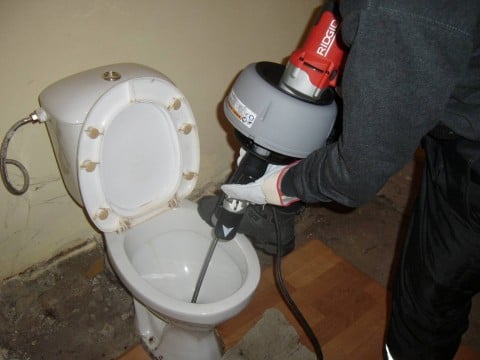
Professional wire rope with electric drive
The cable is used to eliminate complex mechanical blockages located in the distant sections of the pipeline - up to 1.5 - 2.5 m from the drain holes. A cable is introduced into the pipe, carefully advancing it until it stops. Having reached the fence, they begin to rotate the handle. At this time, a lump of dirt breaks up and wraps around the serifs. The rope is slowly removed along with the lump.
Hydrodynamic sewage cleaning method
Professional help is required in situations where the clogged area is so far away that it is not possible to reach the plug with a cable. Experts use electrical equipment for hydrodynamic cleaning.
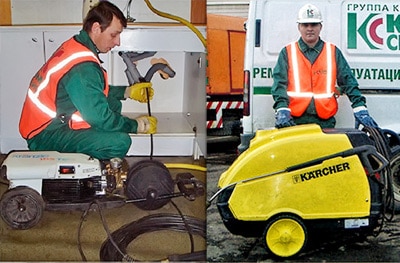
Hydrodynamic cleaning machines
Special nozzles with small nozzles are put on the hose. A jet under pressure comes out through the holes of the nozzles, cleansing the walls from impurities. To wash out the plugs overlapping the inner lumen of the pipes, nozzles with a straight nozzle in the center are used. The generated water hammer is sufficient to clear pipes of any diameter. At the same time, there is no risk to the integrity of the pipeline - the method is used to clean both plastic and metal pipes.
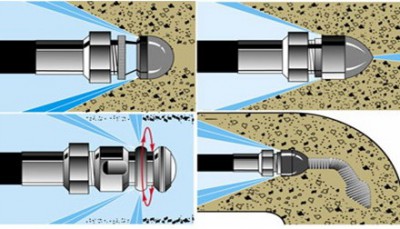
Types of nozzles for different types pollution
Video tutorial on cleaning a sewer pipe with a plumbing cable
Preventive measures, provided they are regular, will help avoid blockages. Install new drain grates, change the corrugation to rigid pipes, use cleaning products every 1 - 2 months. If the pipes are constantly clogged, it is worth identifying the cause and eliminating the structural defects of the system. In the event of a complex blockage, call the wizard: the cleaning procedure will take a minimum of time, and the pipes are guaranteed to remain intact and clean.
Errors associated with the operation of the sewerage system are noted separately. Dumping of garbage, rags, newspapers, leftovers is not allowed building materials directly into the toilet or sink. When in contact with water, waste can form a tight plug, which will be difficult to remove.
Preparing for cleaning
When it is planned to eliminate sewage blockages, cleaning can be performed with minimal time and money, it is important to determine the nature of the problem in a timely manner. Before you do anything, you need to find out what exactly and in what place to clean. Blockages can form in places such as:
- siphon or corrugated drain;
- apartment sewer pipes;
- riser or basement of an apartment building;
- the exit of the pipe of a private house;
- between the wells.
Self-cleaning of sewer blockages is possible in all cases, except for blocking the pipe of an apartment building or the gap between the wells.
The choice of cleaning method depends on the nature and location of the blockage. So, problems in the bathroom are best solved by mechanical methods, and thermal and chemical methods do an excellent job of clogging the kitchen sink.
Mechanical cleaning methods
The action of the mechanical method is based on the use of a special plumbing cable to destroy solid deposits, debris and foreign objects that clog the pipe lumen. That is, to eliminate blockages in the sewage system, cleaning is carried out with a cable. The cable can be made in the form of twisted steel wire, spiral, ruff or hook.
Before cleaning, remove the siphon or hydraulic seal elbow and pour a small amount of boiling water into the pipe. After that, you can insert the cable and slowly advance it to the place of the blockage. When the device rests, you should start rotating the handle located at the other end of the cable. As a result of the rotation transmitted along the length of the cable, the blockage is destroyed, and large debris is pulled out.
The mechanical cleaning method is most effective when removing stones, branches, rags, building material residues and fat deposits.
A plunger can be used as a mechanical means. This device is capable of creating excess pressure and pushing the blockage into a pipe with a large diameter. The use of a plunger has a good effect in conjunction with the chemicals used for cleaning pipes. In this way, women can also clean pipes in this way.
Household chemicals for sewerage
The chemical method of cleaning sewer pipes took as a basis the ability to destroy, soften or dissolve pollution with certain substances:
- alkalis are effective in removing fatty stains;
- acids do an excellent job with organic blockages.
The method is relevant not only during cleaning, but also for maintaining the good condition of the pipes during the operation of the sewage system. Another advantage of the chemical method is pipe disinfection. Before using a chemical agent, be sure to familiarize yourself with its composition. So, acidic solutions are unacceptable for cast iron pipes and can be a problem for buildings with an old sewage system.
Use household chemicals it is possible only in strict accordance with the instructions, which are usually indicated on the packaging of the product. Only in this way will the method be useful and safe for pipes. In the classic version, the agent is poured into the clogged pipe and stays there for a certain time. After that, the system is rinsed with a strong jet of hot water and to improve the result, additional cleaning with a plunger can be performed.
Thermal and hydrodynamic methods
If the grease layer has caused poor wastewater outflow, thermal effects on the pipes can be considered. At least 10 liters of boiling water is poured into a device with a problem of water waste. This method is often combined with the addition of chemicals, as well as with a hydrodynamic procedure.
Hydrodynamic cleaning is considered the most effective, cost-effective and affordable. It is not difficult to master this method on your own, but the acquisition special equipment involves significant material costs. The process consists in flushing the system with a pressure jet of water at a pressure of 150 - 300 atmospheres. The device pumps a working agent into the system, as a result, the blockage is pushed to the central sewer riser. The quality of such cleaning depends on the shape of the nozzles used, selected depending on the pipe diameters, as well as the degree of contamination. The devices, the work of which is based on hydraulic action, are mainly used by professionals.
Blockage prevention
The existing methods of cleaning the clogging of the sewage system do a good job with the problems that arise, but it is better not to allow problems to arise in principle.
Drains of sinks, shower stalls and bathtubs must be equipped with filter grids that trap hair and various small debris. Cleaning should be carried out monthly with special cleaning agents.
After washing greasy kitchen utensils, drain hot water for 1-2 minutes to rinse off the remaining dirt. Most often, the sewage system is clogged as a result of the use of plumbing fixtures for other purposes. It is important to promptly instruct all residents about the rules for operating the plumbing, then you will not have to deal with cleaning the clogging of the sewer often. It is much easier to resort to periodic preventive methods and not throw in sewerage system insoluble substances or objects, the place of which is exclusively in the trash can.



